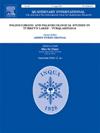Mobility and subsistence change as synchronous adaptation during Holocene climate amelioration: Integrated evidence from the early Holocene Xinglong occupation, southeastern Mongolian Plateau (China)
IF 1.9
3区 地球科学
Q3 GEOGRAPHY, PHYSICAL
引用次数: 0
Abstract
In the southeastern Mongolian Plateau, climate records show drastic changes during the early Holocene and ecological environment underwent extensive amelioration. Meanwhile, a marked decline in residential mobility and an increase in occupational intensity suggest that hunter-gatherers in this region underwent important shifts in their subsistence strategies. This paper examines climate variability and environmental changes during the early Holocene (8.7–7.1 cal ka BP) and their impact on subsistence strategies at the Xinglong site by integrating archaeological, paleoenvironmental, macrobotanical, and faunal assemblage data. These chronologies indicate synchronous changes in climate amelioration, reduced mobility, a notable rise in the consumption of large ungulates, and a modest increase in millet cultivation. These multiple lines of evidence indicate that the warmer and wetter climate facilitated widespread forest expansion, leading to the formation of biomass-rich ecotones in the southeastern Mongolian Plateau. The forest-steppe environment enhanced the distribution and abundance of ungulates and caused resource amelioration likely enabled hunter-gatherers to decrease their residential mobility and concentrate on a narrower foraging spectrum. Millet cultivation was developing and was likely the concomitant of more settled lifeways, but millet starch could have been exploited at a very low level and contributed only minimally to the local economy.
全新世气候改善过程中人口流动与生存变化的同步适应——来自蒙古高原东南部早全新世兴隆地区的综合证据
蒙古高原东南部早全新世气候变化剧烈,生态环境得到广泛改善。与此同时,居住流动性的显著下降和职业强度的增加表明,该地区的狩猎采集者的生存策略发生了重要转变。本文通过综合考古、古环境、宏观植物和动物组合资料,研究了全新世早期(8.7-7.1 cal ka BP)的气候变率和环境变化及其对兴隆遗址生存策略的影响。这些年表表明气候改善的同步变化、流动性的减少、大型有蹄类动物消费的显著增加以及谷子种植的适度增加。这些多重证据表明,温暖湿润的气候促进了蒙古高原东南部森林的广泛扩张,导致了富含生物量的过渡带的形成。森林草原环境增强了有蹄类动物的分布和丰富度,并导致资源改善,可能使狩猎采集者减少了居住流动性,集中在更窄的觅食范围内。小米种植正在发展,很可能是与更稳定的生活方式相伴随的,但小米淀粉的开发水平很低,对当地经济的贡献也很小。
本文章由计算机程序翻译,如有差异,请以英文原文为准。
求助全文
约1分钟内获得全文
求助全文
来源期刊

Quaternary International
地学-地球科学综合
CiteScore
5.60
自引率
4.50%
发文量
336
审稿时长
3 months
期刊介绍:
Quaternary International is the official journal of the International Union for Quaternary Research. The objectives are to publish a high quality scientific journal under the auspices of the premier Quaternary association that reflects the interdisciplinary nature of INQUA and records recent advances in Quaternary science that appeal to a wide audience.
This series will encompass all the full spectrum of the physical and natural sciences that are commonly employed in solving Quaternary problems. The policy is to publish peer refereed collected research papers from symposia, workshops and meetings sponsored by INQUA. In addition, other organizations may request publication of their collected works pertaining to the Quaternary.
 求助内容:
求助内容: 应助结果提醒方式:
应助结果提醒方式:


